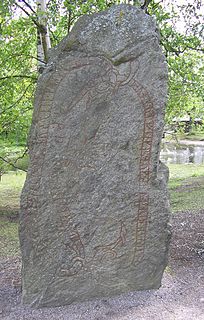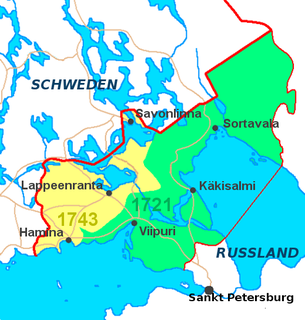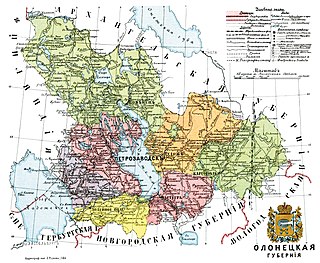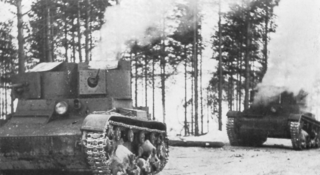 W
WThe History of Karelia is about the cultural and geopolitical region of Karelia, in present-day eastern Finland and northwestern Russia in northern Europe. The Karelian people's presence can be dated back to the 7th millennium BC—6th millennium BC.
 W
WEast Karelia, also rendered as Eastern Karelia or Russian Karelia, is a name for the part of Karelia that since the Treaty of Stolbova in 1617 has remained Eastern Orthodox under Russian supremacy. It is separated from the western part of Karelia, called Finnish Karelia or historically Swedish Karelia. Most of East Karelia is now part of the Republic of Karelia within the Russian Federation. It consists mainly of old historical regions of Viena and Aunus.
 W
WThe Finnish military administration in Eastern Karelia was an interim administrative system established in those areas of the Karelo-Finnish Soviet Socialist Republic (KFSSR) of the Soviet Union which were occupied by the Finnish army during the Continuation War. The military administration was set up on July 15, 1941 and it ended during the summer of 1944. The goal of the administration was to prepare the region for eventual annexation by Finland.
 W
WKarelia is a historical province of Finland which Finland partly ceded to Russia after the Winter War of 1939–40. The Finnish Karelians include the present-day inhabitants of North and South Karelia and the still-surviving evacuees from the ceded territories. Present-day Finnish Karelia has 315,000 inhabitants. The more than 400,000 evacuees from the ceded territories re-settled in various parts of Finland.
 W
WGreater Finland is an irredentist and nationalist idea that emphasized territorial expansion of Finland. The most common concept of Greater Finland was defined by natural borders encompassing the territories inhabited by Finns and Karelians, ranging from the White Sea to Lake Onega and along the Svir River and Neva River—or, more modestly, the Sestra River—to the Gulf of Finland. Some proponents also included the Kola Peninsula, Finnmark, Torne Valley, Ingria, and Estonia.
 W
WThe Karelian question or Karelian issue is a dispute in Finnish politics over whether to try to regain control over eastern Finnish Karelia and other territories ceded to the Soviet Union in the Winter War and the Continuation War. Despite the name "Karelian question", the term may refer also to the return of Petsamo, ceded parts of Salla and Kuusamo, and four islands in the Gulf of Finland. Sometimes the phrase "debate on the return of the ceded territories" is used. The Karelian question remains a matter of public debate rather than a political issue.
 W
WThe Karelo-Finnish Soviet Socialist Republic, also called Soviet Karelia or simply known as Karelia, was a republic of the Soviet Union. It existed from 1940 until it was made part of the Russian SFSR in 1956 as the Karelian Autonomous Soviet Socialist Republic. The latter became the Republic of Karelia, a federal subject of Russia, on 13 November 1991.
 W
WThe Kylfings were a people of uncertain origin active in Northern Europe during the Viking Age, roughly from the late ninth century to the early twelfth century. They could be found in areas of Lapland, Russia, and the Byzantine Empire that were frequented by Scandinavian traders, raiders and mercenaries. Scholars differ on whether the Kylfings were ethnically Finnic or Norse. Also disputed is their geographic origin, with Denmark, Sweden and the Eastern Baltic all put forward as candidates. Whether the name Kylfing denotes a particular tribal, socio-political, or economic grouping is also a matter of much debate.
 W
WLauritsala is a former Finnish market town. It was closed down on 1 January 1967 and was incorporated into Lappeenranta. The present district of Lauritsala comprises only the center of the former town.
 W
WOld Finland is a name used for the areas that Russia gained from Sweden in the Great Northern War (1700–1721) and in the Russo-Swedish War (1741–1743). Old Finland was joined to the autonomous Grand Duchy of Finland as Viipuri province in 1812.In the Treaty of Nystad (1721) that concluded the Great Northern War, Sweden was forced to cede Käkisalmi County and Viborg/Viipuri County to Russia. The ceded Finnish-speaking Ingria around Saint Petersburg, however, was not included in Old Finland. In the Treaty of Åbo (1743) Sweden had to cede the areas in southern Karelia east of the Kymi river and around Savonlinna to Russia.
 W
WThe Olonets Governorate or Government of Olonets was a guberniya (governorate) of north-western Imperial Russia, extending from Lake Ladoga almost to the White Sea, bounded west by Finland, north and east by Arkhangelsk and Vologda, and south by Novgorod and Saint Petersburg. The area was 57,422 m², of which 6,794 m² were covered by lakes.
 W
WThe Republic of Uhtua was an unrecognized state, with the focus of a state led by Finns. It existed from 1919 to 1920, created out of five Volosts in the Kemsky Uyezd of the Arkhangelsk Governorate, now in the Republic of Karelia. The capital of the republic was the village of Uhtua.
 W
WSortavala is a town in the Republic of Karelia, Russia, located at the northern tip of Lake Ladoga near the Finnish border. Population: 19,235 (2010 Census); 21,131 (2002 Census); 22,579 (1989 Census).
 W
WThe Battle of Tolvajärvi was fought on 12 December 1939 between Finland and the Soviet Union. It was the first large offensive victory for the Finns in the Winter War.
 W
WThe Treaty of Åbo or the Treaty of Turku was a peace treaty signed between the Russian Empire and Sweden in Turku on 7. Augustjul./ 18. Augustgreg. 1743 in the end of the Russo-Swedish War of 1741-1743.
 W
WThe Valaam Monastery, or Valamo Monastery is a stauropegic Orthodox monastery in Russian Karelia, located on Valaam, the largest island in Lake Ladoga, the largest lake in Europe.
 W
WThe Vyborg Governorate was a Russian Governorate 1744-1812, which was established in territories ceded by the Swedish Empire in the Great Northern War. By the Treaty of Nystad in 1721, Sweden formally ceded control of the parts of the Viborg and Nyslott County and the Kexholm County located on the Karelian Isthmus and Lake Ladoga area to Russia. First these areas were part of the Saint Petersburg Governorate. Vyborg Governorate was established in 1744 when Sweden ceded control of parts of Kymmenegård and Nyslott County by the Treaty of Åbo. In Sweden the governorate was also known as Old Finland, and between 1802 and 1812 it was named the "Finland Governorate".
 W
WThe Winter War was a war between the Soviet Union (USSR) and Finland. It began with a Soviet invasion of Finland on 30 November 1939, three months after the outbreak of World War II, and ended three and a half months later with the Moscow Peace Treaty on 13 March 1940. Despite superior military strength, especially in tanks and aircraft, the Soviet Union suffered severe losses and initially made little headway. The League of Nations deemed the attack illegal and expelled the Soviet Union from the organisation.